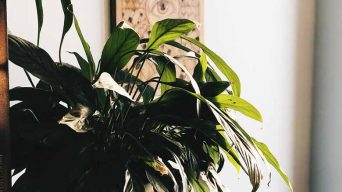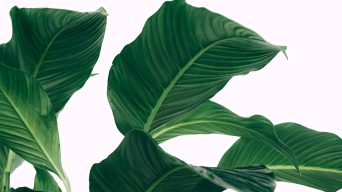An underwatered peace lily is a common problem that can be easily fixed by giving the plant a deep watering. One way to do this is by soaking the peace lily in a sink or basin of water for at least 10 minutes. This will allow the plant to absorb the water it needs and revive the drooping leaves and stems caused by dehydration.
Growing peace lilies as houseplants is a popular choice because of their resilience and low maintenance requirements.
However, even seasoned gardeners may inadvertently neglect watering, leading to an underwatered peace lily.
To effectively address and prevent this issue, it’s crucial to recognize the signs of underwatering and take appropriate measures.
Risks of Underwatering Peace Lily Plants
Watering is a critical factor in caring for peace lilies, influencing various aspects of their well-being.
The role of water extends beyond mere hydration—it serves as the key facilitator for transporting essential nutrients from the soil to the leaves, fueling the process of photosynthesis, and providing the energy necessary for the plant’s growth.
Moreover, proper watering ensures turgidity in stems and leaves, maintaining their firm and healthy state while also acting as a catalyst for new growth in the peace lily.
Conversely, inadequate watering poses several risks to the plant:
1. Stunted Growth
If a peace lily is not receiving sufficient water, its growth will be stunted. Signs of this include smaller leaves and stems and an overall reduction in size. The production of new leaves and flowers will also come to a halt.
2. Root Rot
The roots of a peace lily can decay without proper hydration, leading to root rot. This common issue can be identified by inspecting the roots—black or brown roots are indicative of root rot.
3. Vulnerability to Pests and Diseases
Underwatered peace lilies struggle to absorb moisture and nutrients, becoming more susceptible to pests and diseases. Inadequate watering weakens the plant’s ability to defend against invaders, increasing the risk of infestations or infections.
Common issues include fungal diseases like powdery mildew and botrytis, bacterial diseases like bacterial leaf spot and Pseudomonas cichorii, and pests like aphids, mealybugs, and whiteflies.
4. Flower and Leaf Drop
Insufficient water can lead to flower and leaf drop, with wilted and falling leaves and flowers being clear indicators. This is often a result of dry soil; checking the soil moisture can help identify the cause.
5. Plant Fatality
A lack of water can be fatal for a peace lily, ultimately leading to its death. Without proper hydration, the plant will show signs of drying out—yellowing or browning leaves that slowly drop off, accompanied by shrinking and brittle stems. The entire plant may collapse if deprived of water for an extended period.
Causes of Underwatering
Inadequate watering is a frequent contributor to the demise of peace lilies, as these plants require consistent hydration to thrive.
Without enough water, the foliage can begin to brown and become limp, wilted, and otherwise unhealthy.
There are numerous explanations for why peace lilies may not be receiving the proper amount of moisture they need, such as:
1. Irregular Soil Checks
Gardeners often overlook regular soil checks, leading to underwatering. To ensure proper care, inspecting the top inch of soil weekly or whenever it appears dry is crucial. Immediate watering is necessary if the soil is dry.
2. Infrequent Watering
Consistency is key when it comes to watering peace lilies. While the frequency depends on pot size and light exposure, experts generally recommend at least weekly watering. Neglecting this can manifest in classic signs of underwatering.
3. Unsuitable Soil
The choice of soil matters. Opt for light, well-draining potting soil to facilitate moisture penetration and swift movement through the root zone. Heavy or improperly draining soils can hinder hydration.
4. Inadequate Watering
Watering should be ample. Ensure sufficient water until it drains from the pot bottom. Insufficient moisture can harm the plant.
5. Small Pot Size
Transplant peace lilies to larger pots as they grow. Small pots can hinder water absorption, impacting their growth and health.
6. Low Humidity Placement
Peace lilies thrive in high humidity. Placing them in areas with at least 60% relative humidity prevents issues like wilting or yellowing leaves.
7. Hot, Dry Conditions
During hot, dry weather, increase watering frequency to twice a week. Misting can also elevate humidity around the plant.
8. Poor Drainage
Adequate drainage is crucial. Use light soil and ensure there’s a hole in the pot bottom for water to escape, preventing root issues.
9. Excessive Sunlight
While bright, indirect light is essential, too much direct sunlight can lead to rapid moisture loss. Place the plant where it gets sufficient light without direct exposure, especially in summer.
10. Disease or Pest Damage
Pests and diseases can hinder water absorption. Use well-draining soil, maintain good air circulation, and monitor for issues to prevent damage to the roots.
Identifying Underwatering Signs
Recognizing signs of underwatering in your peace lily is crucial for ensuring your plant’s well-being.
If you notice any of the following symptoms, it’s time to take action:
1. Dry, Crumbly Soil
One of the most telling signs of underwatering is soil that’s dry and crumbly. To check the moisture level, insert your finger into the soil. If it feels dry and lacks stickiness, your plant is likely thirsty and needs water.
2. Drooping Leaves
Underwatering causes peace lily leaves to sag and hang limply. This occurs because the plant can’t absorb enough water to maintain the needed rigidity in its foliage. If the condition persists, leaves may turn yellow and die. The drooping of the leaves serves as a clear indicator that your plant is craving hydration.
3. Yellowing Leaves
Yellowing leaves are unmistakable signs of underwatering in a peace lily. While some yellowing may be attributed to natural aging, if coupled with wilting, it strongly indicates that your plant is not getting enough water. Keep an eye on the edges of the foliage; if they become dry and crisp, it’s further evidence that your peace lily requires more moisture.
4. Brown Spots on Leaves
If your peace lily shows brown spots on its leaves, it clearly indicates it’s not getting enough water. These spots tend to be dry and crispy, concentrated towards the edges of the leaves. This is a sign that the plant is struggling to maintain its health and support its growth. Underwatering can also lead to browning and dryness over time.
5. Wilting Flowers
Insufficient water can cause the flowers of your plant to wilt and turn brown. Wilting is evident in the limpness of the petals, causing them to droop instead of standing upright. If you notice this happening, it’s a definite sign that your plant needs more water to thrive.
6. Slow Growth
Plants without adequate hydration may exhibit signs of underwatering, such as slowed growth. When a plant lacks sufficient water, its development may not progress at the usual rate. You’ll observe minimal or no new growth, with limited leaves or flowers forming. Slow growth is a clear indication that your plant requires more water.
7. Curling Leaves
If your plant isn’t getting enough water, its leaves might start to curl. It’s a clear sign of dehydration, easily noticeable by the dry and brittle edges of the leaves. So, if you spot your peace lily’s leaves curling, check and ensure it’s getting sufficient water.
8. Leaf Drop
Insufficient water can lead a plant to express its distress by dropping leaves. These leaves tend to feel dry and brittle when touched, indicating dehydration. If you observe your plant shedding leaves, it’s crucial to take immediate action and provide the necessary hydration to prevent further damage.
9. Soft Stems
When a plant lacks water, it exhibits various signs, including soft stems. You can identify this condition by observing weak stems that may turn yellow or brown. Soft stems can result from underwatering and overwatering, so assessing your plant’s water needs and ensuring a balanced watering routine is essential.
10. Root Rot
Underwatering poses a risk of root rot for the peace lily, which is easily recognizable by the discoloration of the roots. If the roots appear brown and feel mushy when touched, it indicates root rot. Regularly inspecting the roots can help detect this issue in its early stages. The presence of root rot signals that the plant hasn’t been receiving sufficient water, emphasizing the importance of maintaining proper hydration.
Reviving an Underwatered Peace Lily
If you believe your peace lily is not getting the hydration it needs, there are steps you can take to help it get back on track.
1. Deep and Thorough Watering
Ensure your plant receives a comprehensive watering session. It’s crucial to saturate the soil, allowing water to drain from the pot’s bottom. Aim to water your plant deeply at least once a week—enough to penetrate beyond the surface layer of soil. This ensures the roots absorb the necessary water for the plant’s health.
2. Move to a Humid Location
Revive a peace lily suffering from underwatering by relocating it to a more humid environment. These plants thrive in high humidity and a change to a moister location aids in their recovery. The increased moisture in the air provides the ideal hydration levels for healthy growth.
3. Increase Surrounding Humidity
Elevate humidity by misting your plant with water or using a pebble tray. These methods prevent the leaves from drying out and provide adequate moisture supply.
- Misting: Spray water gently over the plant to increase humidity in its immediate vicinity.
- Pebble Tray: Create a pebble tray by filling a tray with small stones like river rocks or aquarium gravel. Ensure the stones form an even layer. Add enough water to saturate the pebbles, then place your plant on top. As the water evaporates over time, it naturally humidifies the plant’s surroundings. This method also reduces the risk of overwatering through evaporation.
Additionally, a pebble tray offers the benefit of air purification by removing toxins. It serves as a dual-purpose solution, adding moisture while maintaining a healthy environment for your peace lily.
4. Allow Soil to Dry Between Waterings
To revive an underwatered peace lily effectively, a key strategy is to prevent the soil from becoming waterlogged between watering sessions. Start by thoroughly saturating the soil with water and then allow it to completely dry out before the next watering. This practice safeguards the roots from potential rot caused by excessive moisture.
5. Repot in Fresh Soil
When a plant is struggling due to a lack of vitality, repotting it in fresh soil becomes a crucial step in restoring its health. Carefully extract the plant from its current pot and replant it in a new, well-draining medium that allows the roots to breathe.
Over time, soil in containers can become compacted, hindering the roots’ ability to absorb water and nutrients. Repotting serves as an effective method to help the plant regain its vigor.
6. Choose a Pot with Drainage Holes
Taking preventative measures is essential to ensure that an underwatered peace lily receives adequate hydration while avoiding the risk of root rot. One proactive approach is to use a pot with drainage holes. This type of planter ensures that the soil remains moist but not waterlogged. When water is applied, it gets absorbed, and any excess can drain away, promoting a healthier environment for the plant.
7. Opt for Well-Draining Soil
Opt for well-draining soil for an underwatered peace lily to create a healthier growing environment. Incorporate perlite or sand into the soil to promote proper drainage and prevent root rot. Adding organic matter also aids in drainage while providing essential nutrients. As water drains from the pot, it carries away fertilizers and nutrients crucial for the plant’s growth.
8. Prune Damaged Leaves
Insufficient watering can lead to weak, wilted indoor plant leaves with yellow or brown patches. To support the plant’s recovery, prune off these damaged leaves. This action redirects the plant’s energy toward new growth by eliminating any dead or dying foliage.
9. Practice Patience
Reviving an underwatered peace lily takes time, but your patience and care will make a difference. Begin by thoroughly watering the plant, ensuring the soil is completely saturated. Place your peace lily in a location with ample indirect sunlight. Lastly, exercise patience; with your attentive care, the plant will gradually recover and resume healthy growth.
Preventing Underwatering
Maintaining the health of your peace lily requires regular and thorough watering. To achieve this, allow the topsoil to completely dry out between waterings. Typically, this means watering about once a week during the warmer months, adjusting based on your home’s temperature and humidity levels.
Optimal watering practices include using lukewarm water in the morning—never leave your peace lily sitting in water to prevent the risk of root rot. Additionally, opt for distilled or filtered water to safeguard against fluoride and other harmful chemicals. If using tap water, let it sit out overnight before application.
During the growing season, fertilize your peace lily with a diluted water-soluble fertilizer every two to four weeks. However, as growth slows down in fall and winter, cease fertilization during these periods.
Peace lilies thrive in humid conditions. Combat underwatering by misting their leaves with distilled water or placing them in naturally humid environments like bathrooms or kitchens. In regions with low humidity, consider investing in a humidifier to ensure your peace lily flourishes.
By consistently adhering to these guidelines, you’ll guarantee the long-lasting health and vibrancy of your peace lily!
Final Thoughts
The peace lily stands out as a gorgeous and low-maintenance houseplant, known for thriving in low light and enduring periods of neglect. Despite its resilience, it’s essential to remember that, like all plants, the peace lily relies on water for its well-being and may suffer from dehydration if not adequately hydrated.
To detect dehydration, watch for wilting leaves, dry soil, and browning leaf tips. If you spot these signs early on, there’s usually a good chance of reviving the plant with proper watering techniques. To prevent future underwatering, make it a habit to check the soil regularly before watering and ensure your peace lily receives sufficient hydration to maintain its strength and health.







